Livingston, West Lothian
Livingston (Scots: Leivinstoun,[2] Scottish Gaelic: Baile Laobhainn) is the largest town in West Lothian, Scotland. Designated in 1962, it is the fourth post-war new town to be built in Scotland. Taking its name from the village of Livingston in West Lothian, it was originally developed in the then-counties of Midlothian and West Lothian. It is situated approximately fifteen miles (25 km) west of Edinburgh and thirty miles (48 km) east of Glasgow, and is close to the towns of Broxburn to the north-east and Bathgate to the north-west.
Livingston
| |
|---|---|
| New town and administrative centre | |
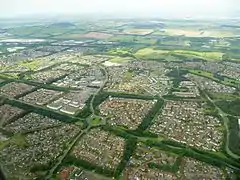 Aerial view of the north west of the town | |
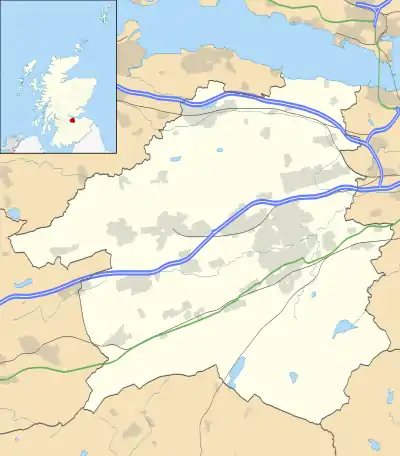 Livingston Location within West Lothian | |
| Population | 57,030 (mid-2016 est.)[1] |
| Language | English, Scots |
| OS grid reference | NT054690 |
| • Edinburgh | 14 mi (23 km) ENE |
| • London | 321 mi (517 km) SSE |
| Council area | |
| Lieutenancy area | |
| Country | Scotland |
| Sovereign state | United Kingdom |
| Post town | LIVINGSTON |
| Postcode district | EH53, EH54 |
| Dialling code | 01506 |
| Police | Scotland |
| Fire | Scottish |
| Ambulance | Scottish |
| UK Parliament | |
| Scottish Parliament | |
The town was built around a collection of small villages, Livingston Village, Bellsquarry and Livingston Station (now part of Deans). It has a number of residential precincts or areas. These include Craigshill, Howden, Ladywell, Knightsridge, Deans, Dedridge, Murieston, Almondvale, Eliburn, Kirkton and Adambrae. There are industrial estates in Livingston, mainly Houston industrial estate, Brucefield, and Kirkton Campus. The locality of Livingston as defined by the General Register Office for Scotland (GROS) includes Uphall Station and Pumpherston. The wider urban settlement, also as defined by the GROS, also includes Mid Calder and East Calder.[3] Other neighbouring villages include: Kirknewton, Polbeth and West Calder. The 2001 UK Census reported that the town had population of 50,826. The 2011 UK Census showed the population of Livingston had increased to 56,269.[4] Livingston is the second-largest settlement in the Lothians after Edinburgh. Until 1963, the area surrounding the ancient village of Livingston was open farmland, and the ancient village is now called Livingston Village.
History
Before 1962
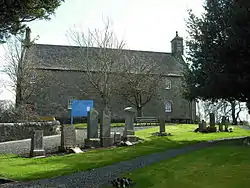
Livingston is first mentioned in an early 12th-century charter as Villa Levingi (Leving's town).[5] In 1128 David I granted the newly founded Abbey of Holyrood control of the church at Livingston and its income in a charter that was witnessed by Turstani filii Levingi (Thurstan Levingsson).[6] He built a fortified tower (Livingston Peel) which no longer survives. The settlement that grew up around it became known as Levingstoun, Layingston and eventually fixed at Livingston. The Leving who controlled the area until dying out in 1512. From 1512 until 1671 the tower house was occupied by The Murrays of Elibank. In 1670, the Edinburgh botanic garden was founded by Dr. Robert Sibbald and Dr. Andrew Balfour using the plant collection from the Elibank private gardens of Sir Patrick Murray, 2nd Lord Elibank, following his death in September 1671.[7] The area of the former gardens and house is now a local garden and park, named Peel park.[8] In the late 17th century, the Peel was demolished and replaced by a house called Livingston Place. The estate eventually passed from the Murray family to the Cunningham family and it was eventually acquired by the Earl of Rosebery in 1828 and demolished in 1840.[5]
The area around Livingston was historically an important shale oil area, the world's first oil boom occurred in West Lothian. This was based on oil extracted from shale, and by 1870 over 3 million tons of shale were being mined each year in the area around Livingston. Output declined with the discovery of liquid oil reserves around the world in the early 1900s, but shale mining only finally ceased in 1962. The "bings" that characterise oil shale mining in West Lothian have largely been flattened. Two shale bings nearby are scheduled monuments - Five Sisters and Greendykes.[9][10]
By 1898, the main Livingston village was recorded as having several houses, a mill, a Church of Scotland church, a United Free church, a school and a coaching inn.[5] The oldest church, Livingston Old Kirk, in its current form, dates from 1732 and is an example of plain Presbetryrian architecture from the Georgian period.[11] It stands on the site of a pre-Reformation church which appears to have stood on the site from c.1350 to 1650.[5] The nearby coaching inn was built in 1760 and the poet Robert Burns is said to have been a guest.[12] The nearby Livingston Mill was also built around the same date, in 1770 although there is evidence that suggests there may have been a mill on the site since the 14th or 15th century.[13] Around 1 mile north of Livingston village there was a railway station with a smaller settlement called Livingston Station which is now part of Deans.[5][14] Livingston station was built as a settlement to serve the workforce and their families of the nearby Deans Oil Works, owned by the Pumpherston Oil Company. Livingston Station had six streets with homes, as well as a store, small church and works institute.[14] The original Livingston railway station was operated by the Edinburgh and Bathgate Railway and opened on 12 November 1849.[15] British Railways closed the station on 1 November 1948 following the ending of passenger services.[15] In the 1980's a site was chosen for a new railway station on the line to the east of the original station and Livingston North station opened on 24 March 1986, concurrent with the re-introduction of passenger services on the line.[15] The Livingston village and Livingston Station settlements were both subsequently incorporated into Livingston new town in the 20th century.[5]
New Town

Under the New Towns Act of 1946 and in part to ease overcrowding in Glasgow, Livingston was designated as a New Town on 16 April 1962.[16][17] Livingston was the fourth new town of five in Scotland; the others were East Kilbride, Glenrothes, Cumbernauld and Irvine. Three villages (Livingston Village and Livingston Station in the old parish of Livingston and Bellsquarry in the parish of Mid Calder) and numerous farmsteads were incorporated into the Livingston new town.[5] Published in July 1962, the first edition of the Livingston plan designated new areas for housing for up to 100,000 people, as well as areas for new industry and offices, marked by new roads, pathways and recreational spaces, under an 84 square mile survey led by Professors Donald Robertson and Sir Robert Matthew.[18][19][20] Many of the initial houses were factory-built. A subsequent edition to the plan was published in 1966 with Livingston intended as the centre of a new population area of up to 250,000 persons in the Lothians.[21]
In order to build, manage and promote Livingston a quango organisation was formed, the Livingston Development Corporation (LDC).[22] Sir David Lowe a local large scale farmer and businessman was appointed chairman.[23][24] Following designation of the new town, the first building begun was the Corporation's own offices in 1963.[19] Residential construction began in 1962 with the first homes to be built as part of the new town being constructed in Deans (to house corporation employees and construction workers).[24] The first major development of the new town took place in Craigshill, with the first people moving into the newly built housing areas of Livingston in April 1964.[5][24] The construction of the areas of Howden, Ladywell and Knightsridge began in the late 1960s and this was followed in the 1970s by the creation of Dedrige and further development of Deans.[24] Some of the first prominent buildings in the new town built in these decades included Riverside Primary School (the first primary school built in the new town in April 1966), the new towns first public house (the Tower in Craigshill built in 1968), Craigshill school (the first secondary school built in the new town in 1969), and the 'Centre' (Livingstons shopping centre) built in 1977.[24]
On 9 November 1979 the Livingston UFO Incident took place, when Robert Taylor, employed by the Livingston Development Corporation, is said to have encountered a UFO on Dechmont Law and the incident was subsequently investigated by Lothian and Borders Police.[25] It is the only UFO incident that was part of a criminal investigation in the United Kingdom.[26]

In 1984 a new railway station was built for the town the Shotts Line called Livingston South which was shortly followed by another station Livingston North on the redeveloped Edinburgh to Bathgate Line in 1986.[15] These stations replaced the former Livingston and Newpark stations which had closed before the construction of the town.[15]
In 1995 Livingston gained its professional football team, Livingston F.C. which was essentially the relocation of Meadowbank Thistle F.C. from Edinburgh.
The Livingston Development Corporation guided Livingston until its mandate expired on 22 March 1997[27] and the town was transferred to West Lothian Council.[28] The last major construction operation carried out by the LDC was the Almondvale Stadium. Housing development continues under West Lothian Council, through private developers, such as Barratt Developments and Bellway, and under the management of housing associations such as the Almond Housing Association and the West Lothian Housing Partnership.[29]
Geography
Livingston is the 8th largest settlement and the 3rd largest town in Scotland, it is also the 171st largest settlement in the United Kingdom. It lies 30 miles away from Glasgow and 15 miles from Edinburgh.
The Livingston new town was planned so that the River Almond runs through the town centre (which is where the Almondvale district in the town also takes its name).[5]
Outer Livingston districts include Wester Dechmont, Deans (including the Deans Industrial Estate), Kirkton and Houston to the north, Craigshill to the east, Bellsquarry (including the Brucefield Industrial Estate) and Murieston to the south, and Adambrae and Kirkton Campus to the east of the town.[5] Craigshill takes its name from the Scottish Gaelic word for the slopes of a hill.[5]
Inner central districts in the town include Almondvale, Livingston Village, Eliburn, Howden, Ladywell, Knightsridge, Dedridge.[5] Ladywell takes its name from a historic well, that was dedicated to Mary and was said to have been used by medieval Scottish Kings as a site for a yearly Royal touching ceremony.[5]
The geology of Livingston is similar to that of West Lothian in general, chracterised by former glacial history and composed of Till.[30][31] This includes areas of clay, sand, silt and gravel, primarily along the Almond river valley environment.[30] Parts of Livingston also have isolated areas of Carboniferous sedimentary rocks (primarily in and around the Deans area of the town) which were worked and extracted for shale oil in the 19th and 20th centuries.[31] The oldest rocks are classified as part of the Inverclyde Group (primarily located in the south-east of Livingston between Linhouse Water and Kirknewton).[31] There are also several areas of underlying Sandstone in Livingston which were used as local quarries, now since defunct, including Dedridge quarry, refilled and landscapped as a local park (Quarry Froggy Park).[31][32]
Until the development of the new town, except for localised industry in areas such as Deans, the area was primarily Agricultural, with farming focused on the alluvial soils of the Almond river.[5] The area is now primarily an Urban area although as a new town, Livingston is characterised by large areas of forested paths, public parks and open spaces.[5] Forested areas in Livingston include Livingston Old Wood (38.97 acres) in Eliburn, the Wilderness in Adambrae (45.91 acres), Bellsquarry Wood (43.86 acres), Kirkton Woods (15.64 acres), Linhouse Glen, and Calder Woods (on the boundary with East Calder.[33][34][35][36]
Employment

The area where Livingston now sits was historically dominated by oil shale mining, which is evident from the bings which still exist on much of the surrounding landscape. The designation of Livingston in the 1960s attracted new light industries to the area, with high technology and pharmaceutical companies moving into the town. Livingston formed a major hub in Scotland's Silicon Glen. Like most other areas this went into a slow decline with the closures of companies including Motorola and NEC. Several multi-national companies still have factories in the town, including Wyman Gordon who manufacturer aircraft components.[37] Sky UK is one of the largest private sector employers in Livingston with a range of offices and their biggest UK contact centre.[38] Shin-Etsu Europe has a manufacturing facility in Livingston that produces semiconductors.[39] Mitsubishi Electric have an electric air conditioning factory in Livingston which produces almost 150,000 air conditioning and heat pump units every year.[40]
Other large employers include Tesco (whose distribution centre for Scotland and Northern Ireland is located on the northern edge of the town), Schuch whose head office and customer service centre is in Livingston,[41] those in the retail sector in the shopping centres and in the health care sector (NHS Scotland), Q Squared Solutions and Quintiles IMS. Glenmorangie, the whisky distillers have offices and a bottling facility in Livingston that was opened in 2011.[42] Witherby Seamanship, established in 1740, is one of the oldest publishers in the United Kingdom and their offices and warehouse is located in Livingston at Navigation House.[43][44] Snag tights is a textile manufacturer based in Livingston that exports to 90 countries.[45]
Valneva SE is a biotech company that has a manufacturing facility in Livingston which produces vaccines, including a vaccine against COVID-19.[46][47]
Town centre

Livingston town centre sits on the southern edge of the Almond Valley and provides shops and services for West Lothian and the surrounding area. It is bounded by a ring road to the east and has been purposely planned, distinguishing it from many other town centres. Howden Park is located immediately north of the town centre and adjoins Howden House, an 18th century house which contains an arts centre and private housing.[48] The south western edge of the town centre is dominated by retail parks.Livingston's town centre also contains a large number of offices. Private sector offices are also concentrated at the eastern and western edges of the centre and along the Almondvale Boulevard. Other facilities in the centre include: hotels, a swimming pool and local authority gym, restaurants and pubs. Almondvale Football Stadium and West Lothian College are located at the north western edge of the town centre.[5]
The Livingston Civic Centre was completed in June 2009 and officially opened by then-First Minister Alex Salmond on 25 November 2009. The Civic Centre is located just north of The centre on the bank of the River Almond. It was home to the divisional headquarters of Lothian and Borders Police until the creation of Police Scotland in 2013, as well as the sheriff and justice of the peace, West Lothian Council, the Crown Office and Procurator Fiscal Service, the Scottish Children's Reporter Administration, Lothian and Borders Fire and Rescue Service and the West Lothian Community Health and Care Partnership.
Shopping

Livingston has three major shopping centres, and another three medium large retail parks and a cluster of small local stores located throughout the different areas. The largest shopping centres are 'The Centre' (formerly named the Almondvale Shopping Centre, comprising more than 1,000,000 square foot of retail space) and Livingston Designer Outlet (the largest outlet mall in Scotland, (formerly called the McArthurGlen Designer Outlet Centre)).[49][50] The combined retail spaces of central Livingston form the largest indoor shopping location in Scotland and the 10th largest in the UK.[50]
The first phase of the Livingston's shopping centres was completed in 1977 to facilitate the needs of the local residents and workers at The centre; known as the "Livingston Centre" at that point.[24] The first major refurbishment was completed in 1988 by Land Securities. The centre was extended by 230,000 sq ft (21,000 m2) in 1996/1997, creating phase 2 of the development, bringing the size of the centre to over 550,000 sq ft (51,000 m2). It has since been renamed "The Almondvale Centre".[24] The centre was completed in its current structure on 16 October 2008. The total development has around 155 shops and eating establishments. In early 1999, construction started on phase 3 of the development with the construction of McArthur Glen Designer Outlet Centre, (reamed as the Livingston Designer Outlet in 2007) and was opened in October 2000, with other work continuing into 2002.[24] The designer outlet mall, Livingston Designer Outlet, contains a VUE multiplex cinema, a food court with many chain fast-food outlets, bars, restaurants and cafés, as well as around 70 outlet shops.[51] In the early 2000s, Asda constructed a new supercentre at the other end of the shopping centre in place of the old Woolco store (which had also been used as a Gateway hypermarket before Asda acquired the firm in late-1989). This Asda supercentre is the largest Asda store in Scotland.[52]
Until 2016, there was also a large B&Q in the south-west of the town centre, as well as a large Morrisons supermarket; which remains open. The Homebase store closed in July 2010 and Argos moved to premises across the road. The former Homebase and Argos stores were converted into a large Sainsbury's supermarket that opened in December 2010. Also in the town centre, are discount supermarkets such as Aldi, and a Lidl which is located beside the Almondvale Stadium.
Under the original Livingston plans, neighbourhood shopping centres were to be located at strategic points around the town and the first of these to be built was The Mall at Craigshill, which claimed to be one of the first covered shopping centres in Scotland.[24] This was followed by the Carmondean Centre in Deans and groupings of shops in Ladywell and Murieston.
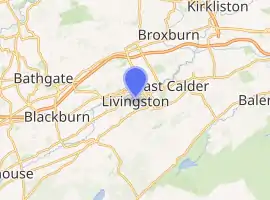
| |
| Location | Livingston, West Lothian, Scotland |
|---|---|
| Address | Almondvale, Livingston Town Centre |
| Opening date | 1976 |
| Developer | Livingston Development Corporation/ Land Securities |
| Owner | Land Securities |
| No. of stores and services | 141 (as of Jan 2018) |
| No. of anchor tenants | 5 |
| Parking | 7200 + plus bus parking (10) |
| Website | thecentrelivingston |
Transport
Road
Livingston has excellent connections to the central Scotland road network. The M8 bounds Livingston in the north. The A899 dual carriageway spine road passes north south along Livingston's eastern edge and connects the M8 in the north to the A71 in the south and has the A89 to the west.
Buses
Livingston has a central bus terminal located on Almondvale Avenue between the two shopping centres in the town centre. This provides regular services to surrounding towns and villages. First Scotland East[53] and Lothian Country Buses are the main bus operator in Livingston, other operators include E&M Horsburgh,[54] Blue Bus, SD Travel and Stagecoach. Livingston has buses to Edinburgh, Glasgow, Edinburgh Royal Infirmary, Lanark, Fife, Falkirk and most West Lothian towns and villages. There are 7 stances at the bus terminal.
Walking / cycling
Livingston has an excellent 'core path network' which is shared use, and available to pedestrians, and cyclists. It connects all of the main areas of the town with shopping, and work areas. It is for the most part 'off-road', and uses an extensive network of under/over pass systems to keep pedestrians and cyclists away from motorised traffic.
Rail
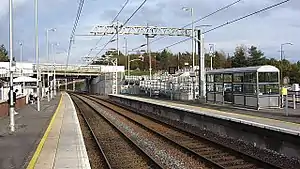
Livingston has three railway stations; Livingston North, Livingston South and Uphall Station (on the eastern edge of Livingston). Livingston North is located adjacent to the Carmondean Shopping Centre between Eliburn and Deans and is on the North Clyde Line. The station opened on 24 March 1986, concurrent with the re-introduction of passenger services on the Edinburgh to Bathgate Line.[15] On 12 December 2010, with the completion of the Airdrie-Bathgate Rail Link, Livingston North is now served by trains running to Glasgow Queen Street and Airdrie.
Livingston South is located at the Murieston Shops and is on the Shotts Line and has trains running between Glasgow Central and Edinburgh Waverley via Shotts. It was opened by British Rail on 6 October 1984.[15]
Airports
Livingston is 6.9 miles (11.1 km) west of Edinburgh Airport and 35.5 miles (57.1 km) east of Glasgow Airport[55] both of which have regular flights to British and international destinations.
Media
The local newspaper covering Livingston is the West Lothian Courier (published under the Daily Record).[56] There was previously a Livingston Post newspaper which was stopped in the early 1990s.[57] There was also a newspaper called West Lothian Herald & Post that served Livingston but that ceased to print in July 2011. Dedridge Grapevine is a voluntary community magazine, delivering several thousand copies to houses in and around Dedridge, founded and edited by Kathleen Ross-Hale since 1976.[58] Konect is a free local magazine that serves the West Lothian area, including Livingston, with approximately 10,000 copies a month delivered in the Livingston area.[59]
Livingston previously had its own Radio Station called River FM that was broadcast from the Almondvale Stadium. River FM broadcast from 1 September 2003 until it was shut down on 29 January 2007.[60] Current local radio includes the local BBC station BBC Radio station is BBC Radio Scotland and local commercial radio includes Capital Scotland and 97.3 Forth One. Livingston also has a Hospital Radio station called Radio Grapevine which broadcasts to St John's Hospital.[61]
Livingston is covered by the BBC Scotland and STV Central regions.
Governance

Local
Livingston is the administrative centre of West Lothian Council.[62] Within West Lothian, Livingston is covered by three multi-member wards each electing four councillors. They are Livingston North, Livingston South and East Livingston and East Calder wards.[63]
Many of the responsibilities of West Lothian Council were previously the responsibility of the Livingston Development Corporation (LDC) until 1997 when the LDC was disbanded.[28]
Scottish Parliament
Livingston is in the Almond Valley constituency for the Scottish Parliament, and the Member of the Scottish Parliament is Angela Constance[64] of the Scottish National Party.[65] Livingston is also covered by the Lothian electoral region which gives the area seven additional MSPs.[66]
House of Commons
Livingston has its own constituency in the House of Commons; Livingston,[67] and is represented by the Scottish National Party Member of Parliament Hannah Bardell.
Livingston for the majority of its existence has returned Labour MPs since the town was founded in 1962. However, in the election of 2015, the constituency voted in Hannah Bardell of the SNP as their member for Parliament.
For the 1983 general election Livingston gained its own constituency at Westminster. The first MP elected for Livingston was Robin Cook[68] who held the seat for six consecutive elections and held many government positions most notably Foreign Secretary between 1997 and 2001. In 2005 Robin Cook suddenly died of a heart attack[69] and a by-election was called[70] and won by the Labour Jim Devine.[71] Devine was deselected in 2009 after being caught up in the 2009 expenses scandal.[72] The current Member of Parliament for Livingston is Hannah Bardell of the SNP who won the seat in the 2015 general election.
European Parliament
Before Brexit, Livingston was part of the Scotland European Parliament constituency. It was represented by six MEPs, the nearest ones to Livingston were Alyn Smith (SNP),[73] Struan Stevenson (Conservative)[74] who were both based in Edinburgh and David Martin (Labour)[75] who was based in Roslin. Livingston used to be part of the Lothians European Parliament constituency.
Education and Libraries

Livingston has 18 nursery schools, 17 primary schools and five special schools.[76] There are four Secondary schools in the town which are Inveralmond Community High School, The James Young High School, St. Margaret's RC Academy and Deans Community High School.[76]
West Lothian College offers higher and further education and its central campus is based in Livingston.[77] The college has sports facilities, a library, and a training restaurant for hospitality students (which was awarded Scottish Restaurant of the Year in 2015 and 2017) and a salon/spa.[77] The college provides educational services to over 8,000 students a year and has 350 staff.[78]
Livingston has three public libraries which are Almondbank Library in Craigshill, Lanthorn Library, Dedridge and Carmondean Library in Deans.[79] A local history library which includes items on the history of Livingston is located in nearby Linlithgow.[79]
Weekend education
The Scotland Japanese School (スコットランド日本語補習授業校 Sukottorando Nihongo Hoshū Jugyō Kō), a weekend Japanese school,[80] is held at St. Margaret's Academy in Livingston.[81] It first opened in 1982 and moved to Livingston in April 2003.[80]
Health
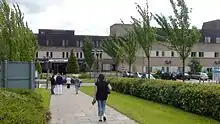
Livingston is part of the NHS Lothian region in NHS Scotland. Livingston previously had a psychiatric hospital with general hospital in the Dechmont area of the town called Bangour Village Hospital, The hospital opened in 1904, and started closing in the 1990s.[82] It closed completely in 2004 after the remaining services were transferred to St John's Hospital.
St John's Hospital, Livingston
Livingston has a large hospital called St John's Hospital in the Howden. The construction of the hospital began in 1981 and opened in 1990.[83][24] The hospital has its own Accident and Emergency and has 550 beds.[84] St John's is a teaching hospital for the University of Edinburgh Medical School.[85]
Culture and recreation

Arts Centre
Howden Park Centre is the arts centre for the town which includes a 300 seat theatre providing arts performances, recitals, plays and other events.[86]
Parks
Livingston has several public parks, including Eliburn park, Almondvale park, Howden park, Peel park, Campbridge park (Murieston), Quarry park (Dedridge), and Bankton Mains park. Eliburn park (in the north-west of Livingston) is a 16.5 hectare site owned by West Lothian Council which features a reservoir (fed by the local Nell burn) with fishing access, sports facilities and a children's play area.[87] Almondvale park, located in the centre of town is an outdoor recreation area, with an adventure playpark, health walk/run and wildflower meadows.[88] Bankton Mains park is a large park with a sports centre, bowling club, tennis and football pitches and play park.[89]
Youth activities
Livingston has its own Air Training Corps squadron, 2535 (Livingston) Squadron (located in Craigshill) and Army Cadet Force unit (based at Dedridge). The town also has Cubs, Scouts, Boys' Brigade, Brownies and Guides units, and other organisations such as LGBT Youth Scotland and the Youth Action Project (WLYAP),[90] and Firefly Youth Theatre (formerly West Lothian Youth Theatre) also operate at Howden Park Centre.[86] The youth action project involves a music session and many gigs and is widely attended by teenagers from the surrounding area.
Livingston Skate Park
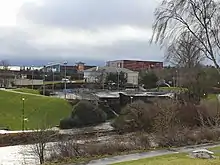
The Livingston Skatepark opened in 1981, at a time when most commercial skateparks were closing and was one of the most important facilities in Britain during a critical period in the development of skateboarding.[91] It is an example of a free, unsupervised facility which achieved international status.[92] The park was designed by Scottish architect Iain Urquhart and was the subject of a 2020 BBC Radio 3 documentary 'Curves and Concrete' which explored the impact the design had on other UK skateparks.[93][94]
Sports
The town has a local cricket club, Livingston Cricket Club, a rugby union club, Livingston Rugby Football Club, a professional football club, Livingston F.C., and a junior football club, Livingston United.
Livingston is also home to; two competitive swimming clubs, the Livingston & District Dolphins and the Aquanauts of Livingston; Livingston and West Lothian Hockey Club, which has several men's and women's teams and provides junior coaching; West Lothian Wolves Basketball Club, with men and women's teams at all age groups and two track and field athletics clubs Livingston & District AAC, and Lothian RC.
Livingston also has a number of youth football teams with the most successful being Murieston United who have teams ranging from the ages of under 9s to under 21s. They have some notable former players: Scott Arfield, Chris Innes, Derek Fleming and Gary Wales.[95]
Livingston FC
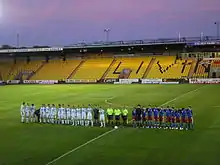
Livingston F.C., known to locals as "Livi" or "The Lions", are the most notable football team in the town. They were formed in 1995 on the relocation of Edinburgh-based side Meadowbank Thistle. The stadium opened in November 1995, but the Livingston name had already been adopted some months earlier when the club was still playing at its former home Meadowbank Stadium in Edinburgh.
Although they were playing in the Scottish Third Division in their first season in Livingston, six years later the club was promoted to the Scottish Premier League, finished third in their first season and qualifying for the UEFA Cup. Relegation to the Scottish First Division in 2006 came after the club entered administration in 2004 as well as other financial problems. In 2009 they narrowly avoided going out of business and as a result were placed back in the Third Division.
The Lions managed to gain promotion to the Scottish Second Division the following year, and returned to the First Division after back to back league championships, on 6 August 2011. They currently compete in the top tier of Scottish Football (Ladbrokes Premiership)
Swimming
Livingston has several swimming pools, the main pool being a 20m public pool run by West Lothian Leisure (Xcite)[96] Other public pools are also located in local schools including Deans Community High School and Inveralmond High School and the Bannatyne Health Club has a private pool for members.
Livingston Cricket Club
Livingston has a cricket club known as the Kingfishers which fields teams for juniors and seniors and has fielded professional paid players. The club plays in the East of Scotland Cricket Association and is based in the Murieston area of Livingston.[97] The Club was founded in 1981 by Dr Salem Patel and Doug Druce, playing its first match in August of that year in Armadale. The club joined the East League for the 1982 season, winning Grade D and promotion.[98] The Club played at several locations in Livingston, including Bankton Mains and at Bangour Hospital sports field.[98] The 1st XI remained in Division 4 until winning the league in 1992.The 1st XI remained in Division 4 until winning the league in 1992.[98] In 1994 sponsorship by the Livingston Development Corporation enabled the club to successfully negotiate the big step up to Division 2 where half of the clubs employed paid professional players.[98] West Indian Mark Harper became the club's first paid player and regularly set new batting records throughout the season.[98] The creation of the National leagues in 1996 and the subsequent re-organisation of feeder leagues saw Livingston become a Division 1 club due to reconstruction of the East League.[98] In 1999 the Club finished third, their highest league position to date.[98] This coincided with a move back into Livingston to a large new ground in the Murieston area.[98] Being almost in the foothills of the Pentlands, rainfall is heavier and the growing season considerably shorter than most of the other grounds in the Central Belt which causes major problems in getting the ground ready for play in April.[98] A new pavillion, the Gerry Toms Pavilion was officially opened on 22 August 2004.[98]
Religion

Christianity
Uniquely in Scotland, Livingston was from its formation designated an "Ecumenical Parish" in a joint initiative by the Church of Scotland, Scottish Episcopal Church, Methodist Church in Great Britain and the Congregational Union of Scotland (which subsequently united with the United Reformed Church). The Ecumenical Parish has six places of worship.
Apart from the Ecumenical Parish, Livingston Old Parish is a congregation solely within the Church of Scotland. There are also churches of other denominations, notably the Catholic Church, the Baptist Church (who have two congregations in Dedridge and Ladywell), Jehovah's Witnesses (who have two congregations: Livingston Deans and Livingston Dedridge) and the Free Church. The Church of Jesus Christ Latter Day Saints has a branch in Deans.
In Livingston there are three Catholic Churches. Saint Peters, in Carmondean, Saint Andrews in Craigshill, and St Philips in Dedridge.[99]
Other religions
There is a mosque in the Craigshill area of the town called Livingston Mosque and Community Centre and also another within the Deans area.[100] In recent years Jehovah Witnesses have built a Kingdom Hall in Eliburn.
Notable Residents
Notable residents of Livingston include Robin Cook, the former MP for Livingston and Foreign Secretary from 1997 until 2001 who died in 2005, and Ian Colquhoun (author, born and educated in Livingston). Actors, musicians and entertainers include Nina Nesbitt (singer songwriter), and David Cicero (singer/keyboardist and associate of the Pet Shop Boys who moved to Livingston as a child).
Livingston sports personalities include Craig Benson (Olympic swimmer and World junior men's breaststroke champion, born and educated in Livingston), Peter 'Snakebite' Wright (born in Livingston, PDC World darts champion), and Elise Christie (short track skater, who competed at the 2010 Winter Olympics and 2014 Winter Olympics. Livingston is the birthplace and home of several Scottish footplayers, including Scott Arfield (football player for Rangers F.C), Mark Burchill (footballer, educated in Livingston), Paul Dickov (former Arsenal player and former manager Doncaster Rovers from 2013–15), James Penrice (professional footballer for Partick Thistle), David Robertson (footballer for St Johnstone F.C.), Jimmy Scoular (former Portsmouth FC and Newcastle Utd football player and Cardiff City manager), Gary Wales (former Hearts player, and Kilmarnock player), Tommy Walker (former Hearts and Chelsea player and manager for Hearts), Keith Watson (footballer, previously for Hartlepool United), and Danny Wilson (footballer, player for Rangers, Liverpool and a former Hearts captain).
References
- "Mid-2016 Population Estimates for Settlements and Localities in Scotland". National Records of Scotland. 12 March 2018. Retrieved 30 December 2020.
- "Scots Language Centre: Scottish Place Names in Scots". Scotslanguage.com. Retrieved 25 December 2011.
- "GROS Website" (PDF). Archived from the original (PDF) on 27 September 2007.
- "Area Profile Populations for Localities in Scotland". Retrieved 24 January 2014.
- William F Hendrie (January 1989). The History of Livingston. ISBN 978-0950216638.
- Livingston Old Parish Archived 2012-03-07 at the Wayback Machine.
- William White (1889). Notes & Queries. Oxford University Press.
- "The Laird O Livingston's Legacy". Konect Magazine. Retrieved 26 November 2020.
- "Five Sisters". Historic Scotland. Retrieved 25 November 2020.
- "Greendykes Ancient Monument". Retrieved 25 November 2020.
- "Livingston Village, Livingston Parish Church". Historic Scotland. Retrieved 25 November 2020.
- "Livingston Inn". Visit West Lothian. Retrieved 25 November 2020.
- "Livingston Mill". Konect Magazine. Retrieved 26 November 2020.
- "Livingston Station Village". Scottish Shale Oil. Retrieved 25 November 2020.
- Raymond Butt (1995). The Directory of Railway Stations: details every public and private passenger station, halt, platform and stopping place, past and present. Parkford: Patrick Stephens Ltd. p. 145.
- "No. 18025". The Edinburgh Gazette. 17 April 1962. pp. 236–237.
- "Life is for Livingston" (PDF). West Lothian Council. Retrieved 25 November 2020.
- "Key Step in Growth of Scotland". The Times. London. 18 July 1962. p. 16. (Subscription required.)
- "New Town Homes Factory-Built". The Times. London. 24 August 1963. p. 4. (Subscription required.)
- "Scotland Leads in Plan for Development Area". The Times. London. 9 March 1965. p. 6. (Subscription required.)
- "£130 million plan for new city in the Lothians". The Times. London. 4 July 1966. p. 9. (Subscription required.)
- "Livingston Development Corporation". Livingston Alive. Retrieved 29 December 2011.
- "Livingston new town is officially inaugurated". Linlithgowshire Journal & Gazette. 20 April 1962.
- Kerr, Marjorie (25 October 2013). "Livingston's history". Daily Record. Retrieved 27 October 2017.
- Bob Taylor (Obituary), The Telegraph 23 March 2007 (2008-04-06)
- Obituary: Robert Taylor, a possible victim of alien abduction, died on March 14th, aged 88 The Economist published 29 March 2007
- "The New Town (Livingston) (Transfer of Property, Rights and Liabilities) Order 1997". Legislation.gov.uk. 22 March 1997. Retrieved 25 December 2011.
- "ICS - Livingston Development Corporation". Livingston Alive. Retrieved 25 November 2020.
- "Almond Housing Association hand over keys to 12 new socially rented properties". Daily Record. Retrieved 17 January 2021.
- "Geology of Britain". British Geographical Society. Retrieved 31 January 2021.
- "West Lothian Geodiversity Volume 1" (PDF). British Geographical Society. Retrieved 31 January 2021.
- "Quarry (Froggy Park)". Caley Construction. Retrieved 31 January 2021.
- "Wilderness". Woodland Trust. Retrieved 31 January 2021.
- "Bellsquarry Wood". Woodland Trust. Retrieved 31 January 2021.
- "Kirkton Woods". Woodland Trust. Retrieved 31 January 2021.
- "Livingston Old Wood". Woodland Trust. Retrieved 31 January 2021.
- "Aviation parts manufacturer in Livingston to cut workforce". BBC News. Retrieved 26 November 2020.
- "Livingston Location Page". Sky. Retrieved 26 November 2020.
- "Shin-Etsu Handotai Europe". Shin-Etsu. Retrieved 28 December 2020.
- "Scotland's Mitsubishi Electric Air Conditioning Factory". B-DACS. Retrieved 28 December 2020.
- "Contact Us". Schuh. Retrieved 26 November 2020.
- "Duke of York opens new Glenmorangie bottling facility". BBC News. Retrieved 26 November 2020.
- "Herald Scotland - Witherby on the Crest of a wave". Retrieved 1 July 2016.
- "Witherby Company Fact Sheet" (PDF). Retrieved 26 November 2020.
- "Brexit hits a snag". BBC News. Retrieved 26 November 2020.
- "Biotech Valneva: European Union to buy '30 million doses of unique West Lothian Covid-19 vaccine'". Edinburgh News. Retrieved 18 January 2021.
- "Scotland factory to produce Valneva Covid vaccine". The Times. Retrieved 18 January 2021.(Subscription required.)
- "History". Howden Park Centre. Archived from the original on 9 February 2010. Retrieved 15 December 2009.
- "Designer home with a dome of its own:McArthurGlen at Livingston has a structured approach to shopping". HeraldScotland. Retrieved 31 December 2020.
- "Key Facts". West Lothian Council. 28 December 2020. Retrieved 28 December 2020.
- "About the Outlet". Livingston Designer Outlet. Retrieved 31 December 2020.
- "ASDA". The Centre, Livingston. Retrieved 31 December 2020.
- "FirstGroup - UK Bus South East & Central Scotland".
- "E&M Horsburgh Coaches, for contract and private hire".
- "Livingston, West Lothian Nearest station/airport(s)". Transportdirect.info. Archived from the original on 23 March 2012. Retrieved 25 December 2011.
- "West Lothian - Latest News". Daily Record. 31 January 2021.
- "Livingston Alive, Livingston Newspapers". Livingstonalive.co.uk. Retrieved 25 December 2011.
- "Dedrige Grapevine, Kathleen Ross". Daily Record. 31 January 2021.
- "About Distribution". Konect Magazine. 31 January 2021.
- John Plunkett (30 January 2007). "River FM hands back licence". The Guardian. Retrieved 25 December 2011.
- "Radio Grapevine". 31 January 2021.
- "West Lothian Civic Centre". Westlothian.gov.uk. 17 October 2011. Retrieved 25 December 2011.
- "West Lothian Multi Member Wards". Westlothian.gov.uk. 13 October 2008. Retrieved 25 December 2011.
- Angela Constance MSP Archived 26 April 2012 at the Wayback Machine
- "Scottish Parliament, Angela Constance MSP". BBC. Retrieved 28 December 2011.
- "Scottish Parliament, Almond Valley". Scottish Parliament. Retrieved 28 December 2011.
- "Parliament.uk: Livingston Constituency". Findyourmp.parliament.uk. Retrieved 25 December 2011.
- "UK General Election results June 1983". Politicsresources.net. 9 June 1983. Archived from the original on 24 September 2015. Retrieved 25 December 2011.
- "Obituary: Robin Cook". BBC News. 6 August 2005. Retrieved 25 December 2011.
- "Date is set for Cook by-election". BBC News. 2 September 2005. Retrieved 25 December 2011.
- "Labour holds Cook's Commons seat". BBC News. 30 September 2005. Retrieved 25 December 2011.
- "Scottish MP 'devastated' by deselection over expenses". Heraldscotland.com. 17 June 2009. Retrieved 25 December 2011.
- "Alyn Smith". Alyn Smith.
- "Scottish Conservatives European Parliament".
- "David Martin MEP". David Martin MEP.
- "Find a school or nursery". West Lothian Council. Retrieved 26 November 2020.
- "Campus and Facilities". West Lothian College. Retrieved 26 November 2020.
- "About us". West Lothian College. Retrieved 26 November 2020.
- "Libraries". West Lothian Council. Retrieved 26 November 2020.
- "概要" (Archive). The Scotland Japanese School. Retrieved on 15 February 2015. "1982年5月 三菱電機、日本電気、ダイワスポーツが中心となり、SDA(現在のSDI、スコットランド国際開発庁)の協力を得て、エジンバラ市のGraigmount High Schoolの教室を借り、生徒数11名、教師3名の複合3クラスでスタートし、その後2003年4月 に上記の所在地に移転、現在に至っています。"
- "欧州の補習授業校一覧(平成25年4月15日現在)" (). Ministry of Education, Culture, Sports, Science and Technology (MEXT). Retrieved on 10 May 2014. "St. Margaret's Academy (High School) Howden South Road, Livingston, EH54 6AT, Scotland"
- "Bangour General Hospital". Archived from the original on 9 November 2007. Retrieved 1 April 2008.
- "LHB64 St John's Hospital". Lothian Health Services Archive. Retrieved 26 November 2020.
- "St John's Hospital Livingston" (PDF). Archived from the original (PDF) on 15 July 2007. Retrieved 1 April 2008.
- "St John's Hospital at Howden". NHS Lothian. 10 July 2012. Retrieved 8 July 2014.
- "About Us". Howden Park Centre. Retrieved 26 November 2020.
- "Eliburn Park". West Lothian Council. Retrieved 26 November 2020.
- "Almondvale Park". West Lothian Council. Retrieved 26 November 2020.
- "Bankton Mains". Visit West Lothian. Retrieved 26 November 2020.
- "WLYAP". WLYAP. Retrieved 25 December 2011.
- "Livingston Skatepark". skateparks.skateboardscotland.com. Retrieved 16 November 2020.
- "The Kids saving an 80s skatepark with some help from Tony Hawk". www.bbc.co.uk. Retrieved 16 November 2020.
- "Sunday Feature: Curves and Concrete". www.bbc.co.uk. Retrieved 16 November 2020.
- "A Week in Radio: Livingston skatepark and the new town experiment". HeraldScotland. Retrieved 16 November 2020.
- "Former Players". Murieston United Club Website.
- "Xcite Livingston". Retrieved 26 November 2020.
- "Livingston Cricket Club". Retrieved 25 November 2020.
- "Livingston Cricket Club History". Retrieved 25 November 2020.
- "Roman Catholic Archdiocese of St Andrews and Edinburgh". Archived from the original on 7 October 2010. Retrieved 28 December 2010.
- "UK Mosque searcher Livingston". Mosques.muslimsinbritain.org. Retrieved 25 December 2011.
Primary sources
- Wills, E (1996) Livingston: the Making of a Scottish New Town
- Cowling, D (1997) An Essay for Today: the Scottish New Towns 1947-1997
- Hendrie, W (1989) The History of Livingston
External links
| Wikimedia Commons has media related to Livingston, West Lothian. |
 Livingston (Scotland) travel guide from Wikivoyage
Livingston (Scotland) travel guide from Wikivoyage- West Lothian Business Portal
- Livingstoni Community site for Livingston
- West Lothian Archaeological Trust